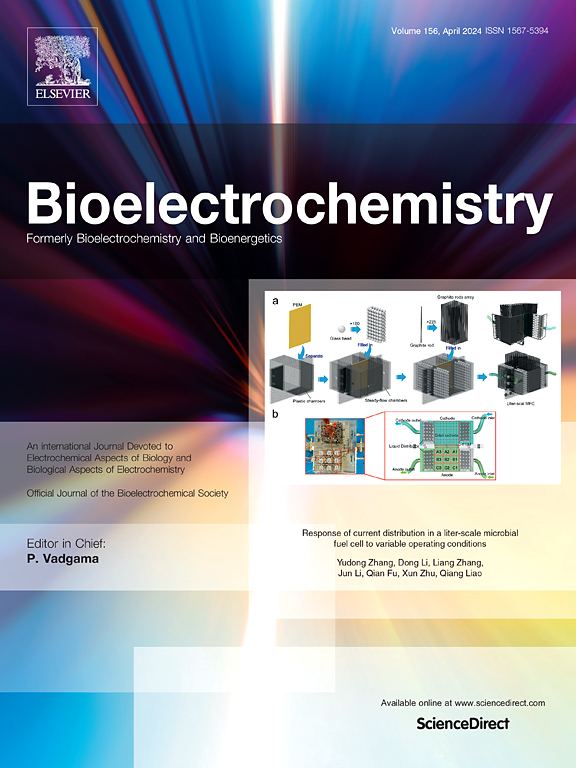A colorimetric and electrochemical dual-modal ochratoxin a aptasensor based on branched hybridization chain reaction signal amplification
IF 4.8
2区 化学
Q1 BIOCHEMISTRY & MOLECULAR BIOLOGY
引用次数: 0
Abstract
Ochratoxin A (OTA), a fungal toxin, induces various toxic effects in animals and humans through the enrichment of toxin residues. In this work, a dual-modal biosensor based on gold nanoparticles (AuNPs) and branched hybridization chain reaction (bHCR) was proposed for the detection of OTA. The strategy is contingent on OTA aptamer-bridged occurrence of bHCR and the salt-induced aggregation of AuNPs. OTA-apt/cDNA could be used to specifically identify the OTA and trigger bHCR reactions, producing a long-branched dsDNA polymer. The electroactive molecule-methylene blue (MB) can be inserted into the superstructure of branched DNA due to the formation of DNA polymers, leading to dynamic changes in MB redox signaling. The residual DNA hairpins were added and adhered to the surface of AuNPs, but they were inadequate to prevent the AuNPs from salt-induced aggregation. The dual-modal yields limits of detection of 4.8 pM (electrochemical assay) and 0.25 nM (colorimetric assay), respectively. It exhibited excellent specificity against common mycotoxins (AFB1, DON, FB1, ZEN), with satisfactory recoveries in corn flour (92.9–108.3 %). This aptasensor, which adopts a dual-modal strategy, features self-calibration to reduce false-positive results and improve accuracy. It demonstrates significant advantages in mycotoxin detection.
一种基于支链杂交反应信号放大的比色电化学双峰赭曲霉毒素配体传感器
赭曲霉毒素A (Ochratoxin A, OTA)是一种真菌毒素,通过毒素残留物的富集对动物和人类产生各种毒性作用。本文提出了一种基于金纳米粒子(AuNPs)和支链杂交链反应(bHCR)的双模生物传感器,用于OTA的检测。该策略取决于OTA适体桥接bHCR的发生和盐诱导的aunp聚集。OTA-apt/cDNA可用于特异性识别OTA并触发bHCR反应,生成长支链dsDNA聚合物。电活性分子亚甲基蓝(MB)可以通过DNA聚合物的形成插入到支链DNA的上层结构中,导致MB氧化还原信号的动态变化。添加了残留的DNA发夹并粘附在AuNPs表面,但它们不足以阻止AuNPs的盐诱导聚集。双模态的检出限分别为4.8 pM(电化学法)和0.25 nM(比色法)。该方法对常见真菌毒素(AFB1、DON、FB1、ZEN)具有良好的特异性,在玉米粉中的回收率为92.9 ~ 108.3%。该传感器采用双模态策略,具有自校准的特点,减少了假阳性结果,提高了精度。它在霉菌毒素检测中具有显著的优势。
本文章由计算机程序翻译,如有差异,请以英文原文为准。
求助全文
约1分钟内获得全文
求助全文
来源期刊

Bioelectrochemistry
生物-电化学
CiteScore
9.10
自引率
6.00%
发文量
238
审稿时长
38 days
期刊介绍:
An International Journal Devoted to Electrochemical Aspects of Biology and Biological Aspects of Electrochemistry
Bioelectrochemistry is an international journal devoted to electrochemical principles in biology and biological aspects of electrochemistry. It publishes experimental and theoretical papers dealing with the electrochemical aspects of:
• Electrified interfaces (electric double layers, adsorption, electron transfer, protein electrochemistry, basic principles of biosensors, biosensor interfaces and bio-nanosensor design and construction.
• Electric and magnetic field effects (field-dependent processes, field interactions with molecules, intramolecular field effects, sensory systems for electric and magnetic fields, molecular and cellular mechanisms)
• Bioenergetics and signal transduction (energy conversion, photosynthetic and visual membranes)
• Biomembranes and model membranes (thermodynamics and mechanics, membrane transport, electroporation, fusion and insertion)
• Electrochemical applications in medicine and biotechnology (drug delivery and gene transfer to cells and tissues, iontophoresis, skin electroporation, injury and repair).
• Organization and use of arrays in-vitro and in-vivo, including as part of feedback control.
• Electrochemical interrogation of biofilms as generated by microorganisms and tissue reaction associated with medical implants.
 求助内容:
求助内容: 应助结果提醒方式:
应助结果提醒方式:


